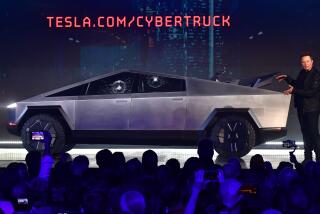Tesla Motors’ net loss more than doubles in fourth quarter

Tesla Motors Inc. reported an unexpectedly large fourth-quarter loss of $320 million on Wednesday as the maker of luxury electric cars incurred heavy costs related to developing two new models.
The Palo Alto company’s primary car is the Model S sedan, and last fall it launched the Model X sport utility vehicle. Tesla also plans a lower-priced, mass-market electric car called the Model 3 for late 2017.
The Model X has been the subject of delays and hefty costs related to ramping up production, and Tesla delivered only 206 of the SUVs in the fourth quarter, well below earlier projections.
Tesla Chief Executive Elon Musk acknowledged that the automaker tried to do “too many great things all at once” that have helped hobble the Model X’s rollout. “There was some hubris with the X,” he told Wall Street analysts on a conference call.
But Musk said those snags were mostly behind the company and “the net result, however, is that I think the Model X is an amazing car.”
Tesla’s fourth-quarter loss using standard “generally accepted accounting rules” compared with a loss of $107.7 million a year earlier. Revenue rose 27% to $1.21 billion from $957 million.
Tesla prefers to focus on its non-GAAP financial results, which are adjusted for leasing factors and other items, but even on that basis Tesla’s loss was much worse than Wall Street expected.
The company’s non-GAAP loss widened to $113.9 million, or 87 cents a share, whereas analysts polled by FactSet Research Systems Inc. had expected a profit of 16 cents a share.
Either way, Tesla’s inability to turn a profit in large part reflected a 42% surge in its operating costs, to $479 million, during the quarter.
But Tesla said it expects to be profitable by the end of this year, and it plans to deliver 80,000 to 90,000 vehicles overall, up at least 60% from 50,580 last year.
That would include producing up to 1,000 Model X vehicles a week during the second quarter, Tesla said, although Musk told the analysts that 1,000 “would probably be a peak production week.”
When asked to forecast the sales mix of the Model S and Model X this year, Musk declined to be precise, saying, “We need to see how customers react when both cars are in the showrooms and we’ll adjust accordingly.”
Tesla said its capital spending in the quarter totaled $411 million, mainly for the Model X, additional retail and service centers and for its so-called gigafactory near Reno, where Tesla is building a giant plant to produce battery packs for its cars.
As for the Model 3, Tesla said it plans to unveil the car March 31 and to start production and deliveries in late 2017.
The growing pains at Tesla, whose cars typically sell for $80,000 to $100,000, have taken a toll on the company’s once high-flying stock.
The results were announced after the stock market closed Wednesday. Tesla shares fell $4.58, or 3.1%, to $143.67 during the session, giving it a 40% loss so far this year.
But the shares rebounded to $156.20 in after-hours trading following the announcement, which drew a divided response from analysts.
“We know the revenue is going up and production is going up, but spending is going up even faster and causing a bigger loss than expected,” said Karl Brauer, senior analyst at Kelley Blue Book.
“The timing of the Model 3 also concerns me because it’s at least a year after the Chevrolet Bolt arrives, and additional pure electrics with a similar range could easily show up by late 2017,” he added.
But analyst Sam Korus of ARK Invest, which owns Tesla stock in three of its
investment funds, said investors should take a longer-term view of Tesla’s development.
“They’re still very much in the ramping [up] process,” Korus said. “People want [production] at scale faster than it is and don’t appreciate the actual cost of getting there.”
The Model X features three rows of seats, can accommodate seven passengers and has doors that open in a “falcon-wing” design.
In taking some of the blame for the Model X’s slow start, Musk said “in retrospect it would have been a better decision to do fewer things with the first version of Model X and then roll in the capabilities and features and new technologies over time.
“I’m not sure anyone is going to make a car like this again,” Musk said. “I’m not sure Tesla would make a car like this again.”
james.peltz@latimes.com
Twitter: @PeltzLATimes







